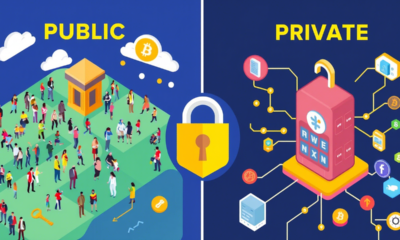DeFi & Yield Farming
Building a DAO: Steps to Launching Your Own Decentralized Organization

|
Getting your Trinity Audio player ready...
|

Building a DAO
Decentralized Autonomous Organizations (DAOs) have emerged as a revolutionary way to organize and govern communities, projects, and initiatives in the digital world. By leveraging blockchain technology, DAOs offer transparency, decentralization, and collective decision-making, making them an attractive option for a wide range of applications. Whether you’re a tech enthusiast, a project leader, or a community organizer, understanding the steps to build a DAO can open up new opportunities for collaboration and growth. In this article, we’ll provide a detailed guide on how to launch your own DAO, complete with practical tips, current data, and valuable insights.
Introduction to DAOs
A Decentralized Autonomous Organization (DAO) is a digital organization that operates through rules encoded in smart contracts on a blockchain. These rules are transparent and immutable, ensuring that the organization functions in a trustless and decentralized manner. DAOs can be used for various purposes, such as managing community funds, governing decentralized applications (dApps), and even running investment clubs. The key features of a DAO include:
- Decentralization: No single entity controls the organization, and decisions are made through community voting.
- Transparency: All transactions and decisions are recorded on the blockchain, making them publicly accessible.
- Immutability: Once the rules are set, they cannot be changed without consensus, ensuring trust and integrity.
- Tokenization: Members typically hold tokens that give them voting rights and other benefits.
Why Build a DAO?
Before diving into the steps, it’s important to understand why you might want to build a DAO. Some of the key benefits include:
- Enhanced Trust: Decentralized and transparent governance reduces the risk of fraud and manipulation.
- Increased Efficiency: Automated processes and smart contracts streamline operations.
- Community Engagement: Token-based voting encourages active participation and community ownership.
- Flexibility: DAOs can be tailored to fit various use cases and industries.
Steps to Launching Your Own DAO
Launching a DAO is a multi-step process that requires careful planning and execution. Here are the essential steps to get you started:
1. Define Your Purpose and Governance Model
- Identify Your Goal: What problem are you solving? What value do you want to create? Clearly define the purpose of your DAO.
- Choose a Governance Model: Decide how decisions will be made. Common models include token-weighted voting, quadratic voting, and liquid democracy.
- Create a Whitepaper: Document your vision, goals, and governance structure. This will serve as a reference for your community and attract potential members.
2. Select the Right Blockchain
- Evaluate Blockchain Options: Popular choices include Ethereum, Binance Smart Chain, and Polkadot. Consider factors like transaction speed, fees, and community support.
- Consider Scalability: Ensure the blockchain you choose can handle the expected volume of transactions and smart contract interactions.
- Testnet and Mainnet: Start with a testnet to experiment and refine your DAO before launching on the mainnet.
3. Develop Your Smart Contracts
- Hire a Developer or Use a Template: If you have the technical expertise, you can write your own smart contracts. Otherwise, consider using a template or hiring a developer.
- Audit Your Contracts: Security is paramount in a DAO. Have your smart contracts audited by a reputable firm to identify and fix vulnerabilities.
- Community Feedback: Share your smart contracts with the community for feedback and suggestions before deployment.
4. Tokenomics and Initial Token Distribution
- Design Your Token: Decide on the type of token (e.g., ERC-20 on Ethereum) and its properties (e.g., supply, vesting schedules).
- Initial Token Distribution: Determine how tokens will be distributed to early members, contributors, and the public. Consider airdrops, token sales, or rewards for early participation.
- Token Utility: Define what your tokens can be used for, such as voting, accessing exclusive content, or receiving dividends.
5. Build a Robust Community
- Engage Early Adopters: Identify and engage early adopters who are passionate about your project. They can help spread the word and contribute to the community.
- Create a Community Hub: Set up a website, social media channels, and a forum (e.g., Discord, Telegram) for communication and collaboration.
- Regular Updates: Keep your community informed with regular updates, progress reports, and transparency about financial transactions.
6. Launch and Market Your DAO
- Initial Launch: Announce the launch of your DAO on relevant platforms and communities. Consider a soft launch to gather initial feedback.
- Marketing Strategy: Develop a marketing plan that includes content marketing, social media campaigns, and partnerships with other projects.
- Token Listing: List your tokens on decentralized exchanges (DEXs) to increase liquidity and accessibility.
7. Govern and Evolve
- Onboarding New Members: Create a clear process for onboarding new members, including how to acquire tokens and participate in governance.
- Regular Proposals: Encourage members to submit proposals for new initiatives, improvements, and changes. Ensure the proposal process is transparent and fair.
- Evolve Based on Feedback: Be open to feedback and willing to make changes to improve the DAO. Continuous evolution is key to long-term success.
Practical Tips for Building a Successful DAO
- Educate Your Community: Provide educational resources to help members understand how the DAO works, how to participate in governance, and the importance of security.
- Foster Collaboration: Encourage collaboration and communication among members. A strong, supportive community is the backbone of a successful DAO.
- Leverage DAO Tools: Use tools like Snapshot, Aragon, and DAOstack to streamline governance and operations.
- Secure Your Funds: Implement multi-signature wallets and other security measures to protect the DAO’s funds from malicious attacks.
- Stay Compliant: Be aware of legal and regulatory requirements in your jurisdiction. Consider consulting with legal experts to ensure compliance.
Case Studies: Successful DAOs
- MakerDAO: A decentralized organization that manages the DAI stablecoin. MakerDAO has a robust governance model and has successfully managed millions of dollars in value.
- AaveDAO: The governance layer of the Aave protocol, which allows users to lend, borrow, and earn interest on their crypto assets. AaveDAO has a large and active community.
- DAOstack: A platform that provides tools and infrastructure for building and managing DAOs. DAOstack has supported several successful projects.
Challenges and Considerations
- Governance Challenges: Ensuring fair and efficient governance can be challenging, especially as the community grows.
- Legal and Regulatory Issues: The legal status of DAOs is still evolving, and different jurisdictions have different regulations.
- Token Economics: Balancing token supply, distribution, and utility is crucial to maintaining the health and value of your DAO.
- Security Risks: Smart contract vulnerabilities and phishing attacks are potential risks. Regular audits and security measures are essential.
Future of DAOs
The future of DAOs is bright. As blockchain technology continues to evolve, we can expect to see more sophisticated and scalable DAOs. Some emerging trends include:
- Cross-Chain Integration: DAOs operating across multiple blockchains to increase interoperability and reach.
- AI and Machine Learning: Integrating AI and machine learning to enhance decision-making processes and automate certain functions.
- Regulatory Clarity: As governments and regulatory bodies become more familiar with DAOs, we may see clearer guidelines and frameworks.
Conclusion
Launching a DAO is a complex but rewarding endeavor. By following the steps outlined in this guide and keeping the practical tips in mind, you can create a decentralized organization that fosters community, transparency, and innovation. Remember, the success of a DAO depends on the strength of its community and the effectiveness of its governance model. Engage, educate, and empower your members to build a sustainable and thriving DAO.
Key Takeaway: Start with a clear purpose, choose the right blockchain, develop secure smart contracts, and build a strong community. Continuous evolution and active governance are key to long-term success.
DeFi & Yield Farming
Advanced Tokenomics: Creating Sustainable Incentive Models


Advanced Tokenomics: Creating Sustainable Incentive Models
Introduction
In the rapidly evolving world of cryptocurrencies and decentralized finance (DeFi), the term “Advanced Tokenomics” has gained considerable attention. Understanding advanced tokenomics is essential for the development of sustainable incentive models, which are key to ensuring the longevity and effectiveness of blockchain projects. In this article, we will delve into the principles of advanced tokenomics, explore its importance, and provide practical insights into crafting sustainable incentive models that can thrive in a competitive market.
What is Tokenomics?
Tokenomics combines “token” and “economics” to describe the economic model that underpins a cryptocurrency or digital token. It encompasses the creation, distribution, and circulation of tokens within a cryptocurrency ecosystem and aims to create a balanced economic environment that promotes growth, sustainability, and user engagement.
Key Components of Tokenomics
- Token Supply: Determines how many tokens will be created, which can be fixed or variable.
- Token Distribution: Details how tokens are allocated among stakeholders, including founders, investors, and the community.
- Token Utility: Explains the purpose that a token serves within its ecosystem, whether as a means of payment, governance, or stake-weighted voting.
- Incentives: Strategies that reward early adopters, contributors, and stakeholders to promote interaction and investment within the ecosystem.
The Importance of Advanced Tokenomics
Advanced tokenomics goes beyond basic principles to create more sophisticated models that consider market dynamics, user behavior, and long-term viability. By integrating advanced tokenomics into project designs, developers can address several critical areas:
Ensuring Long-Term Sustainability
- Market Stability: Advanced models can mitigate price volatility, which is often experienced in the cryptocurrency market. Techniques like dynamic supply adjustments can assist in maintaining stability.
- User Retention: Sustainable incentive models encourage users to remain engaged over time through staking rewards or loyalty programs.
Aligning Incentives
Creating models where the interests of different stakeholders are aligned is crucial. When all parties—users, developers, and investors—benefit from the growth of an ecosystem, it promotes collaboration and reduces conflict.
Fostering Community Ownership
Incorporating community-driven principles fosters a sense of ownership among token holders. Mechanisms such as decentralized governance can empower users to have a say in the protocol’s future, enhancing commitment and loyalty.
Crafting Sustainable Incentive Models
Creating an effective incentive model requires careful consideration and planning. Here are several strategies to keep in mind:
Define Clear Token Utility
Establishing a clear purpose for your token can enhance its value. Tokens could be utilized for transactions, used in governance, or serve as collateral in DeFi protocols. The clearer the utility, the easier it is to attract users and investors.
Implement Staking Mechanisms
Staking allows users to lock up their tokens in exchange for rewards, thus ensuring that they have skin in the game. This not only incentivizes holding but also contributes to network security. Consider deploying a tiered staking system to reward larger stakeholders while still accommodating smaller holders.
Utilize Buyback and Burn Strategies
This strategy involves the project using a percentage of its revenue to buy back tokens from the market and subsequently burn them, reducing the total supply. This approach can increase rarity and encourage upward price movements, all while demonstrating the project’s commitment to sustainability.
Create Incentives for Contributions
Encouraging user participation and contributions, whether through development, marketing, or community support, fosters a vibrant ecosystem. Consider implementing bounties, bonuses, or referral rewards to stimulate activity within your platform.
Monitor and Adapt
The cryptocurrency landscape is highly dynamic. Regular assessment of your tokenomics model is crucial. Use analytics to track user behavior and market trends, and be prepared to adapt your strategies as necessary. Flexibility can be your strongest asset in maintaining sustainability.
Examples of Successful Advanced Tokenomics
Ethereum
Ethereum implements a robust economic model that includes the Ether token as a means of transaction and gas fees, a well-defined supply schedule, and robust staking incentives through Ethereum 2.0. This blend of utility and user incentivization has propelled its growth and adoption.
Binance Smart Chain (BSC)
Binance Smart Chain employs a dual-token system comprising BNB for transaction fees and governance, alongside many tokens in its DeFi ecosystem. Its incentive models provide liquidity mining and yield farming opportunities, driving user engagement and transaction volume.
Conclusion
Advanced tokenomics plays an essential role in building sustainable incentive models within the blockchain ecosystem. By utilizing clear token utility, implementing effective staking mechanisms, and continuously monitoring user engagement, projects can create models that contribute to long-term growth and community trust.
Leveraging advanced tokenomics enhances not only the project’s financial health but also fosters an engaged community that feels valued and invested in the ecosystem’s future. As the blockchain space continues to evolve, embracing these principles will be critical for developers looking to make their mark.
Call to Action
If you’re a project developer or a crypto enthusiast looking to explore the potential of advanced tokenomics further, start by reviewing your current incentive models. Apply these insights to create robust structures that support sustainability and community engagement.
DeFi & Yield Farming
Introduction to Liquidity Pools and How They Work


Introduction to Liquidity Pools and How They Work
In the rapidly evolving world of cryptocurrency and decentralized finance (DeFi), liquidity pools have emerged as a fundamental concept. Understanding liquidity pools and how they work can not only enhance your knowledge of the DeFi space but also present new opportunities for investment and trading.
What are Liquidity Pools?
Liquidity pools are collections of digital assets or tokens held in a smart contract within a decentralized exchange (DEX). These pools provide liquidity, enabling traders to buy and sell tokens without needing a single buyer or seller to facilitate the transaction. Instead, the liquidity is pooled together, allowing for seamless transactions and price stability.
The Importance of Liquidity Pools
Liquidity is crucial for any trading platform, especially in the cryptocurrency market, where asset prices can fluctuate wildly. Without liquidity, users would struggle to buy or sell assets quickly or at fair prices. Liquidity pools alleviate this problem in several ways:
- Facilitating Trades: Enables users to trade 24/7 without the need for an order book.
- Reduced Slippage: With sufficient liquidity, the price impact of large trades is minimized.
- Earning Potential: Users can earn passive income by providing liquidity to these pools.
How Do Liquidity Pools Work?
1. The Mechanism of Liquidity Pools
Liquidity pools operate through smart contracts. When users deposit tokens into a liquidity pool, they receive liquidity provider (LP) tokens in return. These LP tokens represent the user’s share in the pool and can be traded, sold, or redeemed for the underlying assets.
Here’s how the process works:
- Depositing Assets: Users provide tokens by depositing them into the liquidity pool, typically in pairs (e.g., ETH/USDT).
- Automated Market Maker (AMM): Transactions occur through an AMM model, which determines the prices based on the ratio of the assets in the pool. The pricing formula often used is ( x \times y = k ), where ( x ) and ( y ) are the respective quantities of two tokens in the pool, and ( k ) is a constant.
- Earning Fees: Liquidity providers earn a portion of the trading fees generated from transactions that occur in the pool, proportional to their share.
2. Types of Liquidity Pools
While all liquidity pools share the same primary objective—providing liquidity—different types of liquidity pools cater to varied trading strategies:
- Stablecoin Pools: These pools contain stablecoins like USDC or DAI, making them less volatile.
- Single Asset Pools: Users can provide a single type of token, simplifying the process.
- Reward Pools: Some pools provide users with additional rewards in the form of governance tokens or other incentives.
3. The Risks Associated with Liquidity Pools
While liquidity pools can be lucrative, they also come with their share of risks. Understanding these risks is crucial for making informed decisions:
- Impermanent Loss: This occurs when the value of assets in the pool changes compared to holding them separately. The more volatile the assets, the higher the potential impermanent loss.
- Smart Contract Risks: Bugs or vulnerabilities in a smart contract can lead to loss of funds.
- Market Risks: Sudden market movements can affect the liquidity pool’s performance.
Benefits of Liquidity Pools
Engaging with liquidity pools can offer several advantages:
1. Passive Income
Liquidity providers earn fees from trades conducted in the pool. This passive income can be significant, especially in high-volume pools.
2. Access to DeFi Services
By participating in liquidity pools, users gain access to various DeFi services, including yield farming, lending, or borrowing.
3. Token Appreciation
In addition to trading fees, LP tokens themselves can appreciate in value, offering an additional return on investment.
Conclusion: Are Liquidity Pools Right for You?
Understanding liquidity pools and how they work is essential for anyone looking to engage in the DeFi ecosystem. Whether you are aiming to earn passive income, participate in decentralized finance, or hedge against market volatility, liquidity pools present numerous opportunities.
Call to Action
Before diving in, conduct thorough research and consider the risks involved. Start with smaller amounts and increase your investment as you grow more comfortable with the mechanics of liquidity pools.
By exploring liquidity pools and how they function, you’ve taken a step towards unlocking a new dimension of financial opportunities. Embrace the world of decentralized finance and keep learning to maximize your potential!
DeFi & Yield Farming
Step-by-Step Guide to Connecting Your Wallet to DeFi Platforms


Step-by-Step Guide to Connecting Your Wallet to DeFi Platforms
The decentralized finance (DeFi) revolution has transformed the way we think about finance. With the rise of DeFi platforms, users can lend, borrow, trade, and earn interest on their cryptocurrencies without traditional banks. However, to fully engage with this exciting landscape, you need to connect your digital wallet. This Step-by-Step Guide to Connecting Your Wallet to DeFi Platforms will provide you with everything you need to get started successfully.
What is a DeFi Platform?
Before we delve into the specifics of wallet connection, let’s briefly explore what DeFi platforms offer. DeFi platforms are decentralized applications (dApps) built on blockchain technology, primarily Ethereum. They facilitate various financial services, including:
- Lending and Borrowing: Users can lend their assets to others or borrow against collateral.
- Decentralized Exchanges (DEXs): These platforms allow users to trade cryptocurrency directly with one another.
- Yield Farming: This practice enables users to earn rewards by providing liquidity to the market.
The core principle of DeFi is the removal of intermediaries, offering users full control of their assets.
Why Connect Your Wallet?
Connecting your wallet to a DeFi platform allows you to interact directly with smart contracts. Your wallet acts as your gateway to participate in DeFi activities—be it trading NFTs, earning interest, or liquidity mining.
Types of Wallets
There are two main types of wallets commonly used in the DeFi space:
- Hot Wallets: These are connected to the internet and are more user-friendly, making them suitable for everyday transactions.
- Cold Wallets: These are hardware wallets that store your assets offline, providing increased security against hacks.
Step-by-Step Guide to Connecting Your Wallet to DeFi Platforms
Step 1: Choose Your Wallet
First, decide which wallet you want to use. Some popular options include:
- MetaMask: An easy-to-use browser extension and mobile app.
- Trust Wallet: A mobile wallet for both Android and iOS with a user-friendly interface.
- Ledger: A hardware wallet that offers advanced security features.
Step 2: Create and Fund Your Wallet
Once you’ve chosen your wallet, follow these steps:
- Download and Install: Download the wallet application or browser extension.
- Create a New Wallet: Follow the prompts to create a new wallet. Ensure you write down your recovery seed phrase and store it securely.
- Fund Your Wallet: Transfer some cryptocurrency (often ETH for Ethereum-based DeFi platforms) into your wallet. You can buy crypto through exchanges like Coinbase or Binance.
Step 3: Visit a DeFi Platform
Now that your wallet is set up and funded, you can visit a DeFi platform. Some popular platforms include:
- Uniswap: A leading decentralized exchange.
- Aave: A platform for lending and borrowing.
- Compound: Focused on lending with algorithmic interest rates.
Step 4: Connect Your Wallet
Here are the steps to connect your wallet to a DeFi platform:
- Initiate Connection: Look for the “Connect Wallet” button on the DeFi platform’s homepage.
- Select Your Wallet: Choose the wallet you are using (e.g., MetaMask, Trust Wallet).
- Authorize Connection: A pop-up will appear asking you to confirm that you want to connect your wallet. Click “Connect” to proceed.
- Permission Settings: Some platforms require additional permissions to access your assets. Review and grant the necessary permissions.
Step 5: Start Interacting with DeFi
Once your wallet is connected, you can start using the platform. You can swap tokens, provide liquidity, or stake your assets depending on the platform’s offerings.
Best Practices for Using DeFi Platforms
- Security: Always ensure you’re on the correct website. Phishing attacks are common in DeFi.
- Gas Fees: Be aware of transaction fees (gas fees) associated with interactions. These can vary based on the network’s congestion.
- Research: Investigate the DeFi platform and its community before investing. Look for audits and reviews.
Conclusion: Join the DeFi Revolution
This Step-by-Step Guide to Connecting Your Wallet to DeFi Platforms has provided you with the knowledge needed to navigate the DeFi landscape safely and efficiently. With your wallet connected, you can explore endless opportunities for earning and growing your cryptocurrency assets.
Call to Action
Are you ready to dive into DeFi? Choose your wallet today and start exploring the financial freedom that decentralized finance has to offer!
-
Security & Privacy4 months ago
Advanced Techniques for Securing Multi-Signature Wallets
-
Crypto Basics4 months ago
How to Spot Fake News in the Crypto Space: A Comprehensive Guide for Savvy Investors
-
Video4 months ago
Top Mistakes New Investors Make in Crypto
-
Video4 months ago
The Easiest Way to Buy NFTs: A Step-by-Step Guide
-
Investment Strategies4 months ago
Psychological Aspects of Trading: Mastering Emotions for Financial Success
-
Web3 & Metaverse4 months ago
Title: Implementing Zero-Knowledge Proofs in Web3 Applications: A Comprehensive Guide to Security and Privacy
-
Video4 months ago
Public vs Private Blockchain | Difference Between Public and Private Blockchain
-
Regulations & Policy Updates4 months ago
Legal Frameworks for Launching Security Tokens: A Comprehensive Guide for 2025





















































